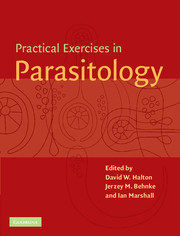Book contents
- Frontmatter
- Contents
- List of contributors
- Preface
- General advice
- 1 Observational Exercises on Parasites
- 2 Ecology
- 2.1 Pin worms (Nematoda, Oxyuroidea) in the American cockroach, Periplaneta americana
- 2.2 Distribution and microhabitat of a monogenean on the gills of mackerel
- 2.3 Population dynamics of Gyrodactylus on stickleback
- 2.4 Intraspecific competition in the cestode Hymenolepis diminuta, in rats
- 2.5 Transmission dynamics and the pattern of dispersion of the cestode Hymenolepis diminuta, in the intermediate host population
- 3 Physiology and Biochemistry
- 4 Pathology and Immunology
- 5 Chemotherapy
- 6 Molecular Parasitology
- 7 Behaviour
- Appendix 1 Reagent index
- Appendix 2 UK suppliers
- Appendix 3 US suppliers
- Index
2.2 - Distribution and microhabitat of a monogenean on the gills of mackerel
Published online by Cambridge University Press: 05 June 2012
- Frontmatter
- Contents
- List of contributors
- Preface
- General advice
- 1 Observational Exercises on Parasites
- 2 Ecology
- 2.1 Pin worms (Nematoda, Oxyuroidea) in the American cockroach, Periplaneta americana
- 2.2 Distribution and microhabitat of a monogenean on the gills of mackerel
- 2.3 Population dynamics of Gyrodactylus on stickleback
- 2.4 Intraspecific competition in the cestode Hymenolepis diminuta, in rats
- 2.5 Transmission dynamics and the pattern of dispersion of the cestode Hymenolepis diminuta, in the intermediate host population
- 3 Physiology and Biochemistry
- 4 Pathology and Immunology
- 5 Chemotherapy
- 6 Molecular Parasitology
- 7 Behaviour
- Appendix 1 Reagent index
- Appendix 2 UK suppliers
- Appendix 3 US suppliers
- Index
Summary
Aims and objectives
This exercise is designed to demonstrate:
Site selection by a parasite.
Niche segregation by a parasite in the absence of competitors.
Relationships between parasite numbers, site selection and host size.
The manner in which parasites are dispersed throughout a host population.
Introduction
Although we often talk loosely about parasites living in or on a host, this should not be taken to imply that they can live in all tissues or organs of a host. Indeed, all parasites show some degree of site specificity in that they are only found in a particular organ or tissue and are able to select that site. Many of the adaptations they exhibit, e.g. an attachment mechanism, are actually adaptations to this particular site rather than to the host as such.
Interpretations of site selection within an ecological framework are not generally agreed. There is a large measure of agreement that the site of a parasite can be used as an indication or measure of its niche, but far less agreement about the ecological significance of, especially, very specific site selection (i.e., narrow niche breadth) and its relationship to resource partitioning and intra-and inter-specific competition between parasites. Many species appear to increase their niche breadth at higher densities and this is often taken as a manifestation of intra-specific competition. Similarly, species packing within an organ and a narrower niche breadth is considered by many workers to be a likely indication of inter-specific competition.
- Type
- Chapter
- Information
- Practical Exercises in Parasitology , pp. 141 - 146Publisher: Cambridge University PressPrint publication year: 2001



